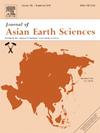藏南拉萨地体中部早侏罗世沉积记录:对特提斯洋俯冲和增生的启示
IF 2.7
3区 地球科学
Q2 GEOSCIENCES, MULTIDISCIPLINARY
引用次数: 0
摘要
拉萨地体中部中三叠世—早侏罗世盆地的性质对确定直港-松都洋与雅鲁藏布江洋的关系具有重要意义。在野外地质调查的基础上,利用岩石学、锆石U-Pb年代学和铬尖晶石电子探针分析对拉萨地体中部麦龙岗—雄来盆地贾拉堡组进行了研究。贾拉堡组是一套以中粗粒碎屑岩为主,安山岩和英安质凝灰岩为夹层的火山-沉积地层。碎屑锆石U-Pb年龄谱显示出220 ~ 180 Ma的初级年龄峰,650 ~ 500 Ma和1250 ~ 1050 Ma的次级年龄峰。加权平均后,贾拉堡组最大沉积年龄(MDA)为184±1 Ma,表明贾拉堡组主要沉积于早侏罗世。物源分析表明,加拉堡组碎屑物质主要来源于直港-苏岛增生杂岩中的增生弧,部分来源于南缘冈底斯基底和同代岩浆弧。根据区域地质调查结果,下侏罗统贾拉堡组具有楔顶盆地向弧后盆地过渡的特征,是直孔-松岛洋和雅鲁藏布江洋连续俯冲-增生形成的盆地。本文章由计算机程序翻译,如有差异,请以英文原文为准。
The Early Jurassic sedimentary records in the Central Lhasa Terrane, southern Tibet: Implications for the subduction and accretion of the Tethys Ocean
The properties of the Middle Triassic to Early Jurassic basin in the Central Lhasa terrane are highly important for defining the relationship between the Zhikong-Sumdo Ocean and the Yarlung-Tsangpo Ocean. The Jialapu Formation in the Mailonggang-Xionglai Basin in the Central Lhasa terrane was studied utilizing petrology, zircon U–Pb chronology, and chromium spinel electron probe analysis on the basis of geological investigations in the field. The Jialapu Formation is a set of volcanic-sedimentary strata that are mainly composed of medium- to coarse-grained clastic rocks, with andesite and dacitic tuff interlayers. The U-Pb age spectrum of detrital zircon shows a primary age peak of 220–180 Ma and secondary age peaks of 650–500 Ma and 1250–1050 Ma. After weighted averaging, the maximum depositional age (MDA) of the Jialapu Formation was 184 ± 1 Ma, indicating that the Jialapu Formation was deposited mainly in the Early Jurassic. The provenance analysis revealed that the clastic materials of the Jialapu Formation were derived mainly from accretionary arcs in the Zhikong-Soumdo accretionary complex, and partly from the Gangdese basement and coetaneous magmatic arcs in the southern margin. On the basis of the results of the regional geological survey, the Lower Jurassic Jialapu Formation exhibits a transitional property from the wedge-top basin to the back-arc basin, which is a basin resulting from the continuous subduction-accretion of the Zhikong-Sumdo Ocean and Yarlung-Tsangpo Ocean.
求助全文
通过发布文献求助,成功后即可免费获取论文全文。
去求助
来源期刊

Journal of Asian Earth Sciences
地学-地球科学综合
CiteScore
5.90
自引率
10.00%
发文量
324
审稿时长
71 days
期刊介绍:
Journal of Asian Earth Sciences has an open access mirror journal Journal of Asian Earth Sciences: X, sharing the same aims and scope, editorial team, submission system and rigorous peer review.
The Journal of Asian Earth Sciences is an international interdisciplinary journal devoted to all aspects of research related to the solid Earth Sciences of Asia. The Journal publishes high quality, peer-reviewed scientific papers on the regional geology, tectonics, geochemistry and geophysics of Asia. It will be devoted primarily to research papers but short communications relating to new developments of broad interest, reviews and book reviews will also be included. Papers must have international appeal and should present work of more than local significance.
The scope includes deep processes of the Asian continent and its adjacent oceans; seismology and earthquakes; orogeny, magmatism, metamorphism and volcanism; growth, deformation and destruction of the Asian crust; crust-mantle interaction; evolution of life (early life, biostratigraphy, biogeography and mass-extinction); fluids, fluxes and reservoirs of mineral and energy resources; surface processes (weathering, erosion, transport and deposition of sediments) and resulting geomorphology; and the response of the Earth to global climate change as viewed within the Asian continent and surrounding oceans.
 求助内容:
求助内容: 应助结果提醒方式:
应助结果提醒方式:


